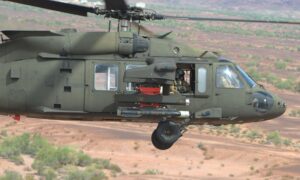Army officials on Wednesday said data collected at this past fall’s Project Convergence (PC) experiment has shown progress toward the idea of a “joint integrated fire control network,” focused on the ability to seamlessly pass data and connect capabilities across the services.
During a Center for Strategic and International Studies discussion, officials discussed lessons learned from PC ‘21 to include operating new capabilities in simulated degraded environments, the role of the network as “the backbone,” and advancements in the sensor-to-shooter space.

Col. Toby Magsig, the Army’s deputy exercise director for Project Convergence, detailed the idea of a “joint integrated fire control network,” which he noted is an informal name, and said it requires tying in air and missile defense, long-range precision fires and the tactical network.
“Really, it’s this assimilation of technologies to be able to do both offensive and defensive fires, active and passive sensing and third-party shooting off of other people’s sensings. It’s really taking future technologies that are coming down the pipe along with existing legacy programs of record, integrating them together across all five services and then [having] the ability to pass data seamlessly between. And that’s not easy,” Magsig said during the discussion.
Lt. Gen. James Richardson, the acting head of Army Futures Command, noted PC ‘21 included experimenting with over 100 technologies, compared to 30 the year before, and expanding to seven distinct use cases where the initial primary focus was on the ‘sensor-to-shooter’ space.
Magsig noted PC ‘21, which included increased participation from the other services, was intended to answer questions such as which technologies would help defeat adversaries’ Anti-Access/Area Denial Capabilities and how much bandwidth would be required to enable joint all-domain operations, with the use cases testing the limits of the experimental capabilities and ability to share data.
“You can’t get at Joint All-Domain Operations unless you can seamlessly pass data. Gen. Richardson has said data is the new ammunition and it really is. Without access to and the ability to share, parse, understand and recode data, you’re sort of left fighting how we did in the ‘80’s and ‘90’s, and that’s not going to be good enough against the adversaries that we’ve already talked about,” Magsig said.
Data gathered from PC ‘21 has informed a new proposal the Army has put together for the Joint Chiefs of Staff J6 directorate that aims to set joint standards for message formats to more easily share information among different services’ platforms, according to Magsig.
“We developed standards for message formats that either don’t exist today or the formats that exist today don’t enable us to fight in a way that we need to fight today and beyond. So this is really about creating optionality for a joint force commander. It’s about giving him a range of plays instead of just one play,” Magsig said.
On the network, Richardson said the Army must continue to improve the ability to “process at the edge,” while noting the progress made at PC ‘21 in range extension through mesh networking.
“With the mesh network, we extended the division commanders’ battlespace by over 150 kilometers. That will allow us to operate in dispersed formations to increase our survivability. Because as everyone knows, you can’t hide today so you’re probably going to have to operate in smaller formations in dispersed terrain,” Richardson said. “We broke the network a couple times just to see how much it would take. We learned a tremendous amount on the network. But I think, as an Army, we’re going in the right direction with our new Integrated Tactical Network that we’re fielding today.”
Army officials previously told reporters the ability to get nearly a three-times increase in its mesh network range extension was achieved with fewer assets than was required at PC ‘20 (Defense Daily, Nov. 9).
Both Richardson and Magsig added that a goal for PC ‘22 will be to see how progress the Army and the joint force have made in the ability to operate both new capabilities and legacy systems, while passing data, in simulated degraded environments.
“We’ve got to be able to understand that our adversaries are going to deny us in the GPS, they’re going to sever our comms link, they’re going to jam and they’re going to obfuscate in the electromagnetic spectrum. So if you know they’re going to do that, then you can start to say how do we have the ability to maneuver around those capabilities,” Magsig said.